Homeostasis, Body Temperature Regulation, Fever, and Hyperthermia
1/58
There's no tags or description
Looks like no tags are added yet.
Name | Mastery | Learn | Test | Matching | Spaced |
|---|
No study sessions yet.
59 Terms
Definitions of homeostasis
A condition or variable fluctuates in a predictable and often narrow range. But when disturbed, it goes back to normal
Steady state
A condition that does not change with time; requires energy to maintain a constant condition
Equilibrium
A condition in which opposing forces are balanced; no energy is required
Steady State or Equilibrium?
Body temperature regulation
Na+ concentration inside and outside a cell
Osmotic concentration inside and outside a cell
Body temperature regulation - Steady State
Na+ concentration inside and outside a cell - Steady State
Osmotic concentration inside and outside a cell - Equilibrium
Osmolarity in Equilibrium (4)
Water goes freely in and out through a water channel
Osmolarity is the same
Amount going in = amount going out
No energy
Na+ concentration in steady state NOT in equilibrium (6)
Keeps it fairly constant
Enters via a channel down its concentration gradient
Pumped out using ATP
Concentration differs
Amount going in = amount going out
NEEDS energy
Set point definition
The steady state value for any variable that the body attempts to maintain. NEGATIVE FEEDBACK
A few examples of homeostatic variables (i.e. have a set point) (6)
• Body temperature
• Na+ concentration inside and outside the cell
• Blood glucose concentration
• Total body water
• Blood pressure
• ATP concentration in a cell

Lable
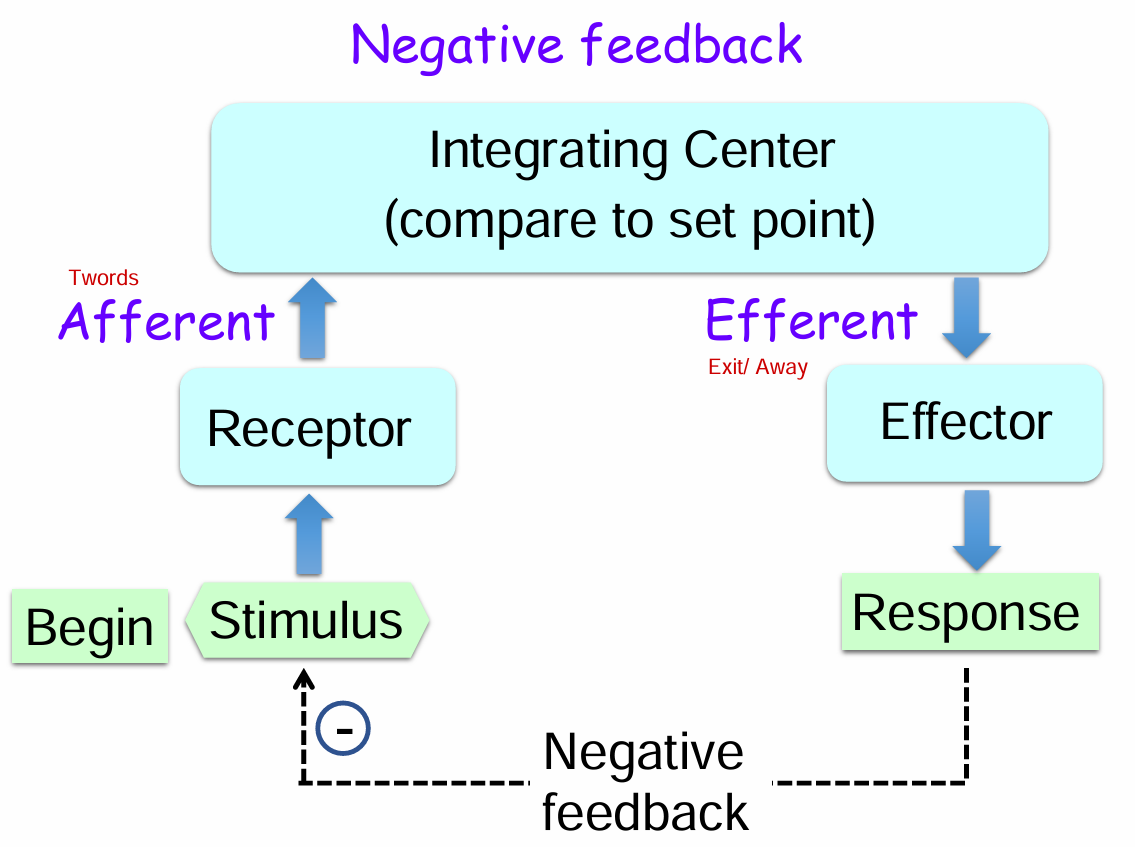
What does negative feedback accomplish?
If a variable goes out of the acceptable range, the negative feedback response brings it back to the set point

Sensor or Receptor Definition
Detect a change
Integrating Center Definition
Receive information from one or multiple sensors, coordinate the information, and tell the effector what to do
Effector Definition
Produce a response
Homeostatic regulation of Body Temperature
Variable
Sensor
Afferent
Integrating Center
Efferent
Effector
Result
Variable - High BT
Sensor - Thermoreceptors on internal organs
Afferent - Neurons sends signals to the brain
Integrating Center - Brain (compare to set point)
Efferent - Neurons send signal to the skin
Effector - Skin
Result - Increase heat loss
After eating an ice cream cone, glucose is absorbed causing an increase in blood glucose levels. This stimulates the pancreatic beta cells to secrete insulin. The insulin acts on muscle and adipose tissue to increase their uptake of glucose, which causes a reduction in blood glucose levels. Which is the integrating center in this scenario?
A. Muscle and adipose tissue
B. Pancreatic beta cells
C. GI tract
D. Blood
B. Pancreatic beta cells
Homeostatic regulation of Blood Glucose
Variable
Sensor
Integrating Center
Efferent
Effector
Result
Variable - High BG
Sensor - Pancreatic beta cells (compare to set point)
Integrating Center - Pancreatic beta cells (compare to set point)
Efferent - Insulin
Effector - Skeletal muscle and adipose tissue
Result - Takes up BG
Typical signals in a homeostatic response (1)(2)
A neuron or hormone that sends information
From the receptor to the integrating center
From the integrating center to the effector
There are also positive feedback responses What do they accomplish?
Accelerates a process
What are examples of a positive feedback loop? (select all that are correct)
A. An increase in respiratory rate during exercise
B. Blood clotting when you have a cut
C. Dilation of the pupils when you enter a dark room
D. Milk let down when an infant is nursing
E. Parturition or birth of a baby
B. Blood clotting when you have a cut
D. Milk let down when an infant is nursing
E. Parturition or birth of a baby
Body temperature regulation Why is it necessary? (2)
Biochemical reactions are temperature dependent
If body temperature is too high, then neurons malfunction and proteins denature
Environmental temperature
Peripheral or central thermoreceptors?
A more specific location?
Peripheral
Skin
Core body temperature
Peripheral or central thermoreceptors?
A more specific location? (3)
Central
Hypothalamus
Deep body organs
Spinal cord
Homeostatic response for core body temperature regulation
Variable
Variable
Sensor
Afferent
Integrating Center
Efferent
Effector
Result
Variable - Core temp is too hot or too cold
Sensor - Central thermoreceptors In hypothalamus, spinal cord, viscera
Afferent - Sensory Neurons are signal
Integrating Center - Hypothalamus (compare to set point)
Efferent - signal depends on the effector (Typically neuron)
Effector - Multiple
Result - Necessary response
Feed forward response to changes in skin (ambient) temperature
Variable
Sensor
Afferent
Integrating Center
Efferent
Effector
Result
Variable - Skin temp is too hot or too cold
Sensor - Peripheral thermoreceptors on skin
Afferent - Sensory Neurons
Integrating Center - Hypothalamus (compare to set point)
Efferent - Signal depends on the effector but same as core temp regulation
Effector - Multiple
Result - Necessary response
What happens to you when you get cold? Decrease circulation to the skin (skin gets pale)
The efferent signal?
The effectors (or how does this happen?)
Why does this happen?
The efferent signal? - Nervous system (SNS)
The effectors (or how does this happen?) - Blood vessels (arterioles) to the skin constrict
Why does this happen? - Reduce heat loss
What happens to you when you get cold? Shiver
The efferent signal?
The effectors (or how does this happen?)
Why does this happen?
The efferent signal? - Nervous system
The effectors (or how does this happen?) - Skeletal muscle contracts
Why does this happen? - To generate heat
Radiation definition
Heat emission in the form or electromagnetic energy or waves
Conduction definition
Transfer of heat via thermal energy (collision of 2 adjacent molecules)
Convection definition
Conduction of heat aided by movement of air or water next to the body
Babies can’t shiver so they
So they exhibit nonshivering thermogenesis to generate heat and stay warm
Nonshivering thermogenesis pathway (4)
Cold exposure →
Epinephrine, SNS, thyroid hormone →
Brown adipose tissue (thermogenic tissue) →
Uncoupling of oxidative phosphorylation
What does uncoupling of oxidative phosphorylation mean?
Using glucose to make ATP
Uncoupling of oxidative phosphorylation pathway (3)
Oxidation (metabolism and release of energy) →
Uncoupling proteins inhibit Phosphorylation (production of ATP) →
Produce heat instead of ATP
What are your behavioral responses when you get cold? Advantages? (3)
Fold your arms - Reduces surface area for heat loss
Put on more clothes - Insulation to prevent heat loss
Move to a warmer environment - Self explanatory
What happens when you get hot? Increase circulation to the skin (skin gets red)
The efferent signal?
The effectors (or how does this happen?)
Why does this happen?
The efferent signal? - Nervous system SNS
The effectors (or how does this happen?) - Blood vessels (arterioles) to the skin dialate
Why does this happen? - To increase heat loss by RCC
What happens when you get hot? Sweat
The efferent signal?
The effectors (or how does this happen?)
Why does this happen?
The efferent signal? - Nervous system SNS
The effectors (or how does this happen?) - Sweat glands produce More sweat
Why does this happen? - To lose heat by evaporation
Any skeletal muscle and behavioral changes when you get hot?
Cooler place, fan yourself
Two ways to lose heat by evaporation (2)(2)(1)
Insensible water loss (600 ml/day)
Diffusion of water through the skin
Exhaling
Sweating
Involved in homeostasis
You are taking a bath and the temperature of the water is 80oF. You get out of the tub and very quickly dry off, and the room temperature is 75oF. How does your body maintain its core temperature?
A. Cutaneous vasoconstriction
B. Shivering
C. This is a small change, so no reflex response is necessary
A. Cutaneous vasoconstriction
What is the thermoneutral zone (for a nude individual), what happens at the thermoneutral zone, and what happens above and below?
Environmental temperature (75-86 degrees)
Blood flow to the skin can regulate core temperature
If below - Add heat generation (eg shiver)
If above - Add sweating
You are in Death Valley National Park, CA where the temperature is 105oF, and the relative humidity is 13% (average relative humidity in WI in the afternoon is 64%). How does your body keep cool?
A. Sweating
B. Cutaneous vasodilation
C. Decreasing it’s basal metabolic rate
D. Both cutaneous vasodilation and decreasing basal metabolic rate
E. Both cutaneous vasodilation and sweating
A. Sweating
If temperature higher than body temp, vasodilation does not happen
In a hot and humid environment, is sweating more efficient, less efficient, or have the same efficiency in reducing core body temperature as in a hot and dry environment?
A. More efficient
B. Less efficient
C. Same efficiency
B. Less efficient

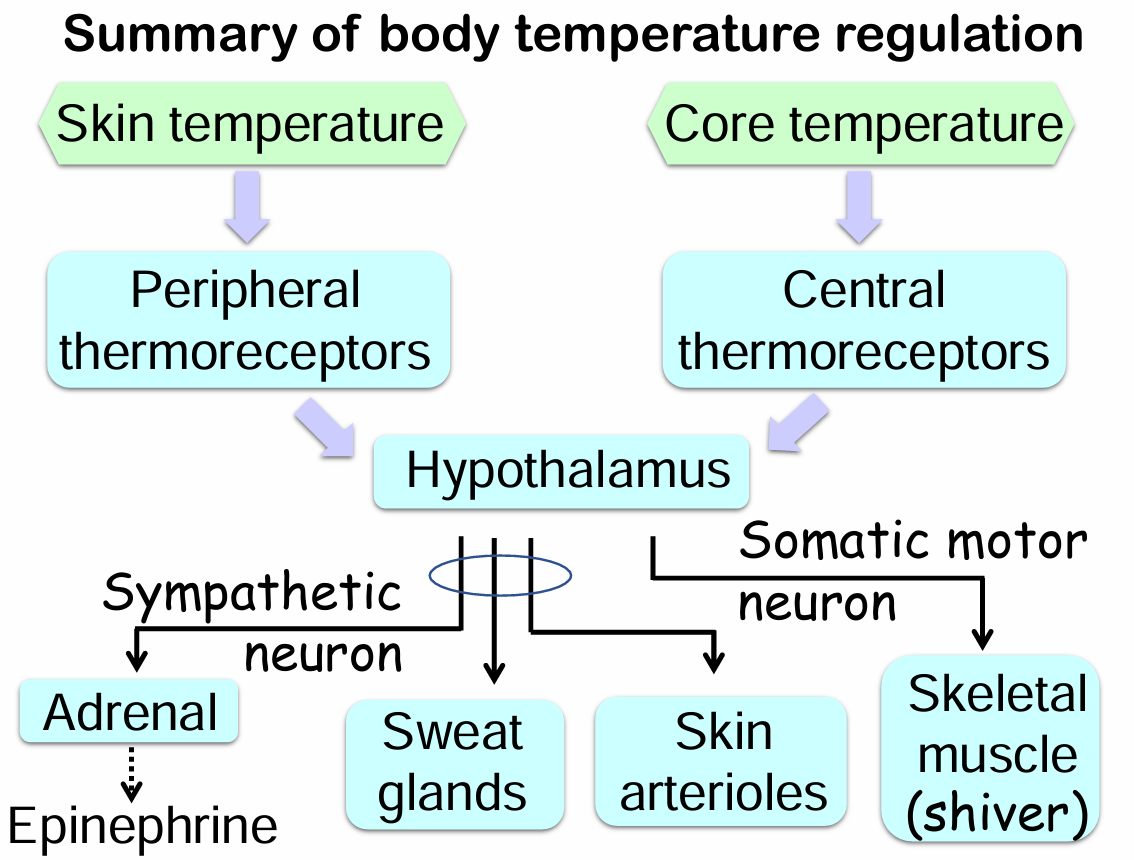
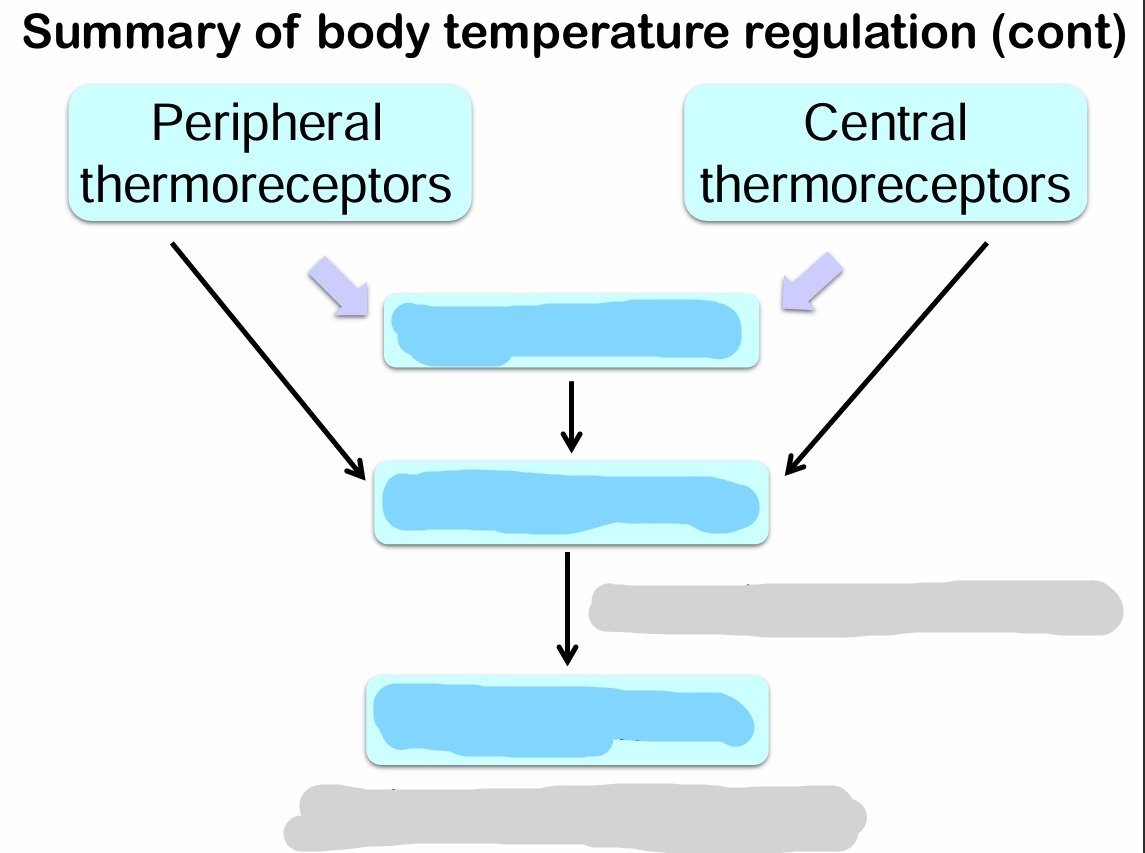
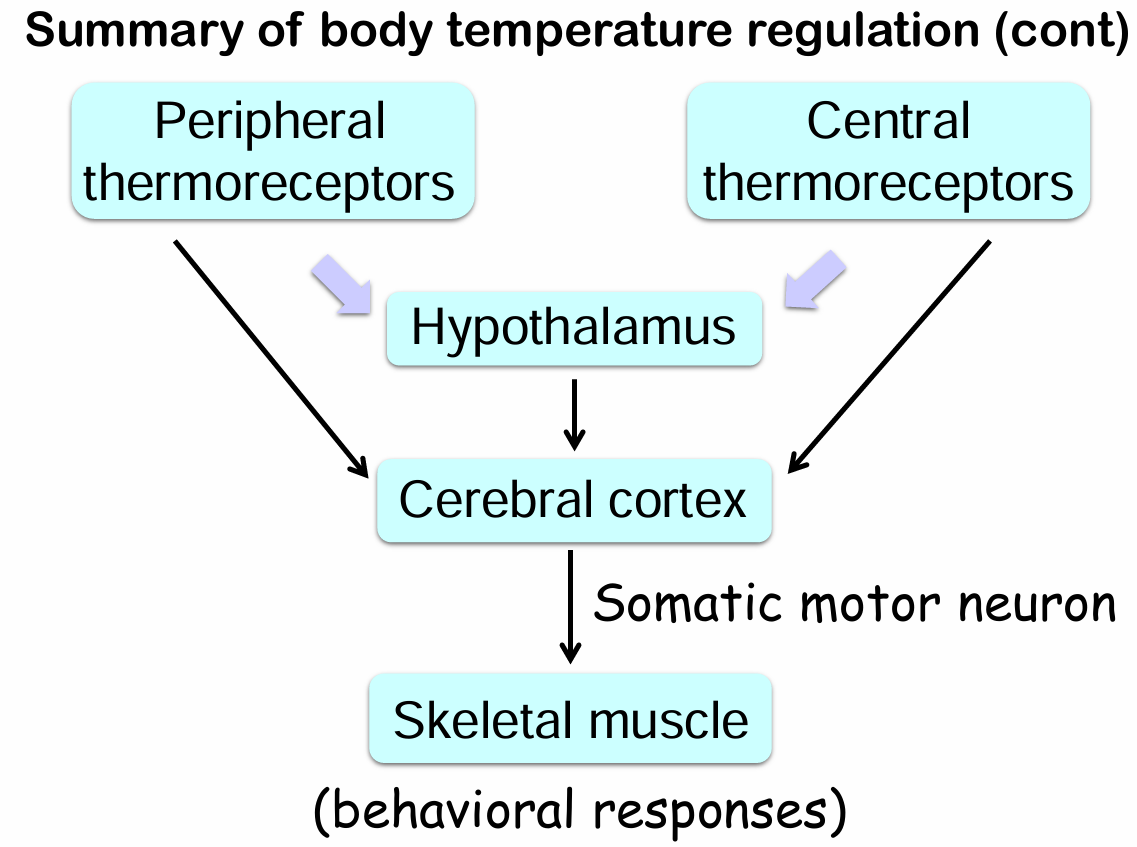
Fever pathway (7)
Infection or other fever producing stimulus →
Macrophages
Release endogenous pyrogens (EP)
Interleukin 1B (IL-1B)
Interleukin 6 (IL-6)
Tumor necrosis factor-a (TNF-a)
Brain →
Cells release prostaglandin E2 (PGE2) →
Raises the set point of the hypothalamus →
Body responds by activating reflexes that will raise core or body temperature
Will you shiver or sweat during a rapid onset of a fever? What else might happen?
Shiver
Vasoconstriction
Hyperthermia is often caused by
exercise
With hyperthermia, what do you think happens to the set point and core body temperature?
A. Core body temperature does not change
B. Core body temperature decreases
C. Core body temperature increases
D. The set point does not change
E. The set point decreases
F. The set point increases
C. Core body temperature increases
D. The set point does not change

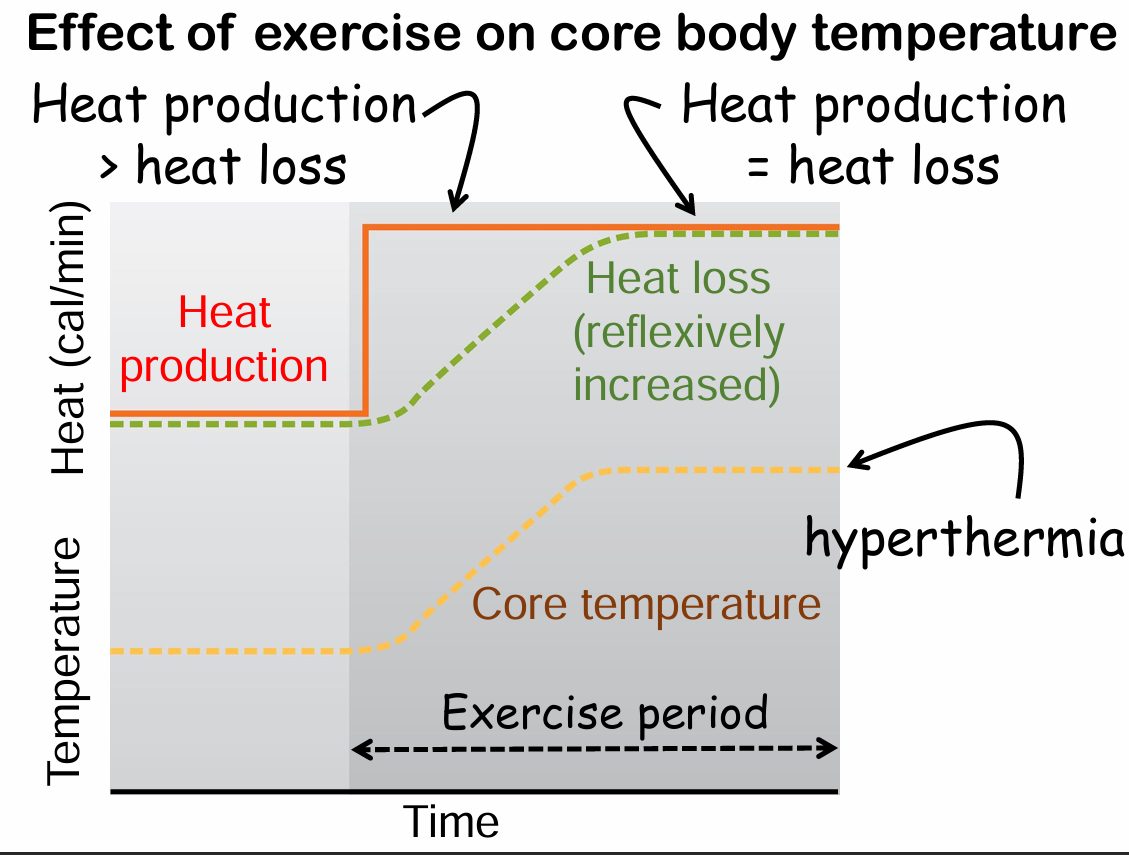
What happens if a person develops hyperthermia, but things get worse?
They can develop heat exhaustion and then eventually heat stroke!
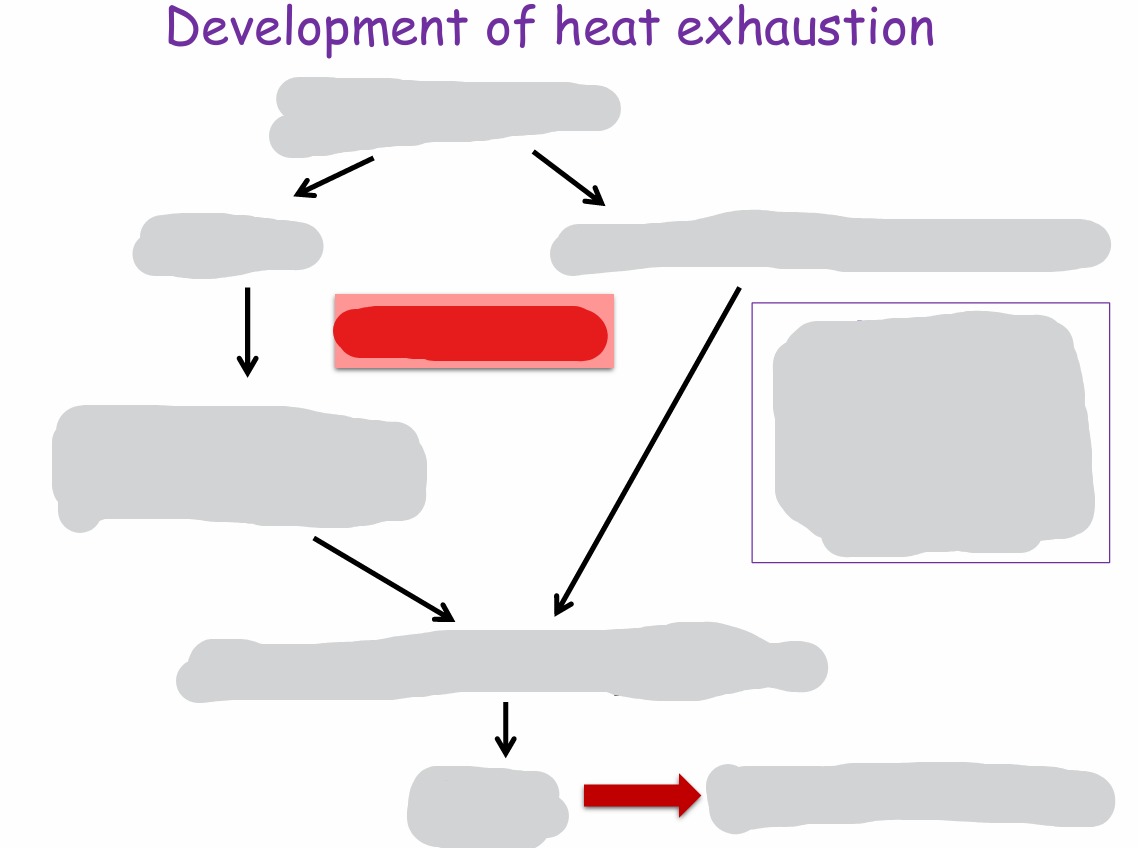

What will most likely happen to core body temperature with heat exhaustion? Are the cooling mechanisms still working?
Higher
Yes, Since they are working, core body temperature will usually be less than 104oF
Why does heat stroke develop? (3)
The body’s ability to regulate it’s temperature totally breaks down
Cooling system is ineffective
Core temperature continues to rise
Key Consequences of heat stroke (2)(2)
Excessive hyperthermia
Core temperature > 104oF
Neurological problems
Seizures, altered consciousness, persistent delirium
Other consiquences of Heat stroke (2)(1)
Not sweating – skin hot and dry
Note: sometimes sweating!
Skin can also become pale instead of red
An individual with heat stroke may be dry (not sweating) and pale (cutaneous vasoconstriction). Why? (1)(2)(3)
Dehydrated
Decreased BP
Reflex vasoconstriction of cutaneous arterioles (help maintain BP to perfuse the brain)
Reduced blood flow to he skin
No extracellular fluid to make sweat
No extracellular fluid to make sweat
Hypothermia is most often caused by
exposure to cold weather or immersion in a cold body of water.
Why does immersion in cold water rapidly cause hypothermia? (2)
Heat transfer in water is about 100 times better than in air →
Body loses heat faster than it can produce heat
What is the body’s response to hypothermia? (2)
Shivering
Vasoconstriction